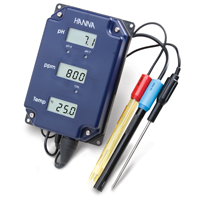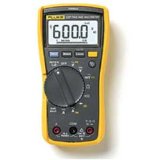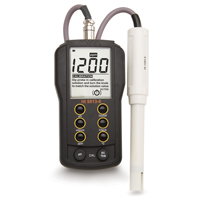


Search This Site
Search With Google
Examples Of The Hydroponic Moisture Meter
Hydroponic Moisture Meter
Moisture Meter Guide
The complete moisture meter website
Hydroponics is a way of growing plants in water, using mineral nutrient solutions and no soil. Terrestrial plants can be grown using such mediums as gravel, mineral wool, expanded clay and rock wool. It was in the 18th century when researchers actually discovered that soil acts as a mineral nutrient reservoir and that soil is in fact not essential to plant growth. Basically, as long as the necessary mineral nutrients are added to a plant's water supply, that plant does not require soil to flourish.
Advantages of hydroponics
You do not require any soil
Any water can be reused, so a less water supply is required
You have complete control over nutrient levels
No pollution
Very stable growing method mthat gives high yields
Getting rid of pests and disease is so much simpler
Moisture Meter Guide 2010 Contact details:garnett65@hotmail.com
Water culture system -
For the water culture system you will require;
Reservoir
Grow tray
Media
Nutrients
pH/TDS/EC controller
Wick system -
What you require for the wick system are;
Reservoir
Grow tray
Media
Air pump
Diffuser
Nutrient solutions
pH/EC/TDS tester
Hanna HI 981504 ph/TDS/Temperature Monitor
This hydroponic tool from Hanna is very easy to setup and install. It will give the gardener a simultaneous display of ph/TDS and temperature. All you do is locate the area you want to monitor, plug the indicator in and immerse all 3 probes. All 3 readings will be displayed by 3 backlit LCDs. The unit is waterproof protected to give it a longer life in more extreme conditions. Cleaning and maintaining the unit is very easy.
Hanna HI 9813-
This hydroponic tool from Hanna is a tool specially designed for use with hydroponics. The large LCD displays the parameter being measured and has a built in CAL CHECK so that you can check the calibration of the unit whenever you desire. You can switch parameters at any time with just a push of the button. Calibration is simple and the battery power percentage is always shown. The multiparameter probe is of fast response. There are even on screen tutorial messages to help you set up the unit.
Harvesting is simpler
No plant damage from pesticides
Disadvantages of hydroponics
Without soil, plants do not have a buffer. This can lead to speedy plant death if there is any failure within the hydroponic system
Pathogen attacks like damp off
Different fertilizers required for different methods
Hydroponic Growing Systems
Aeroponic system -
Reservoir
Pump
Spray nozzles
Nutrient solutions
Grow media
A pH tester and a EC/TDS controller
Drip Growing System -
For the drip system you will require;
Reservoir of water
Pump
Lines and a drip manifold
A suitable grow tray
Nutrient solution
Air pump
Diffuser
pH/EC/TDS controller
Ebb and flow system -
The timer switches on and the grow tray is flooded. Whne the timer switches off, the nutrient solution is pulled back to the reservoir.
The whole system can be modified to suit certain plants. Rocks or gravel can be placed in the grow tray. One drawback, though, to this system is that a power outage or pump failure can have disastrous effects.
For the ebb and flow system you will require;
Reservoir
Pump
Grow tray
Nutrient solutions
Air pump
Diffuser
pH/EC/TDS meter
Nutrient Film Technique -
For the nutrient film technique you will require;
Water reservoir
Pump
Grow tray
Media
Nutrient solution
Air pump
Diffuser
pH/EC/TDS monitor
To Care Is To Share


For more information on the above 2 units or any other Hanna instrument check out the official Hanna website >
| Tramex Moisture Encounter Plus |
| Tramex Compact Wood Moisture Meter |
| Tramex Concrete Encounter Moisture Meter |
| Tramex Skipper Plus Moisture Meter |
| Tramex Roof And Wall Moisture Scanner |
| Sonin Digital Moisture Meter model 50218 |
| Sonin Digital Moisture Meter 270 model 50270 |
| Sonin Moisture Test Tool model 50210 |
| Sonin Moisture Test Meter Model 50211 |
| Oak |
| Douglas Fir |
| Beech Tree |
| Elm Tree |
| Hickory Tree |
| Maple Tree |
| Pine Tree |
| Prevent And Repair Gaps In Wooden Floorboards |
| How To Fix A Squeaky Hardwood Floor |
| How To Repair A Hardwood Floor That Has Buckled |
| Which Is The Best Firewood? |
| Concrete |
| Concrete Moisture |
| Screed Moisture Meter |
| SDS Drill |
| Belle Cement Mixer |
| SDS Drill Advice |
| Which SDS Drill |
| SDS Drill Accessories |
| Drilling Into Concrete |
| Kennedy Tool Box |
| Moisture - Basic Facts |
| Types Of Damp |
| Wet Rot |
| Dry Rot |
| Mold |
| Water Leak Detection |
| Stucco Moisture |
| Water Damage |
| Moisture And Rust |
| Moisture Damage To A Chimney |
| Wallpaper Stripper |
| Plaster Mixer |
| Why Worry About Moisture Problems |
| Does Your Home Have A Moisture Problem? |
| How To Solve Moisture Problems |
| How To Use Anti Mold Paint |
| Rising Damp |
| Condensation |
| Salt Damp |
| How To Avoid Bathroom Condensation |
| How To Remove Black Mold |
| How To Prevent Bathroom Mold |
| Soldering Kit |
| Soldering Kit Contents |
| Soldering Kit Advice |
| Bonsai Tree Classification |
| Growing Bonsai From Seed |
| Bonsai Tree Care |
| Bonsai Tree Training |
| Bonsai Tools |
| Displaying Bonsai |
| Bonsai Calendar |
| Bonsai Plants |
| The Thirsty Light Curve Moisture Meter |
| The Thirsty Light Ladybird Moisture Meter |
| The Thirsty Light Bumble Bee Moisture Meter |
| The Thirsty Light Butterfly Moisture Meter |
| Hanna Instruments |
| Agratronix Portable Coffee Moisture Tester |
| Lawn Aerator |
| Lawn Roller |
| Lawn Rake |
| Lawn Sand |
| Chainshot |
| Chainsaw Gloves |
| Chainsaw Trousers |
| Chainsaw Boots |
| Mac 4 - 20 XT Chainsaw |
| Mac 738 Chainsaw |
| Mac 842 Chainsaw |
| Mac 20X Power Chainsaw |
| Einhell BG-PC 3735 Chainsaw |
| Einhell BG-PC 4040 Chainsaw |
| Einhell BG-PC 5045 Chainsaw |
| Poulan P3314 Chainsaw |
| Poulan P4018 Chainsaw |
| Poulan Pro PP3816AV Chainsaw |
| Poulan Pro PP4218AVX Chainsaw |
| Poulan Pro PP4620AVX Chainsaw |
| Efco MT 4100 SP Chainsaw |
| Efco MT 3500 Chainsaw |
| Efco 132 S Chainsaw |
| Efco 147 Chainsaw |
| Efco 152 Chainsaw |
| Efco MT 7200 Chainsaw |
| Efco MT 8200 Chainsaw |
| Efco MT 3750 Chainsaw |
| Methods Of Obtaining Soil Moisture Levels |
| Hygrometer |
| Psychrometer |
| Rain Gauge |
| Wave Ventilation System |
| Humidity |
| Hygrometer For Keeping Reptiles |
| Humidor |
| Weather Stations |
| Musical Instrument Storage |